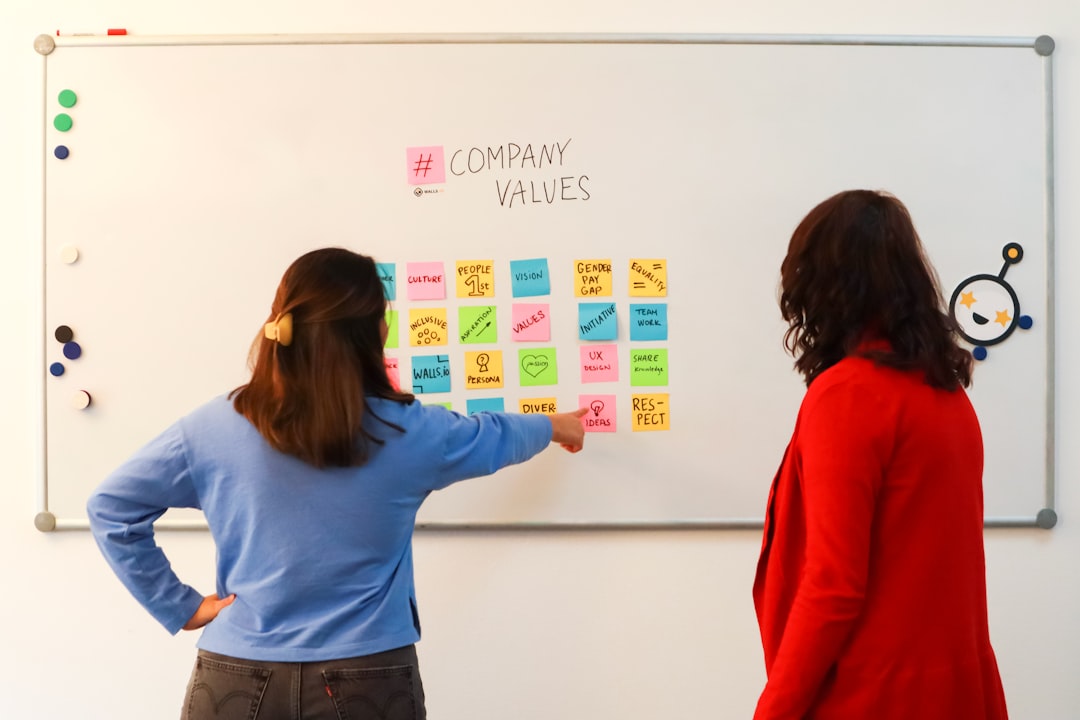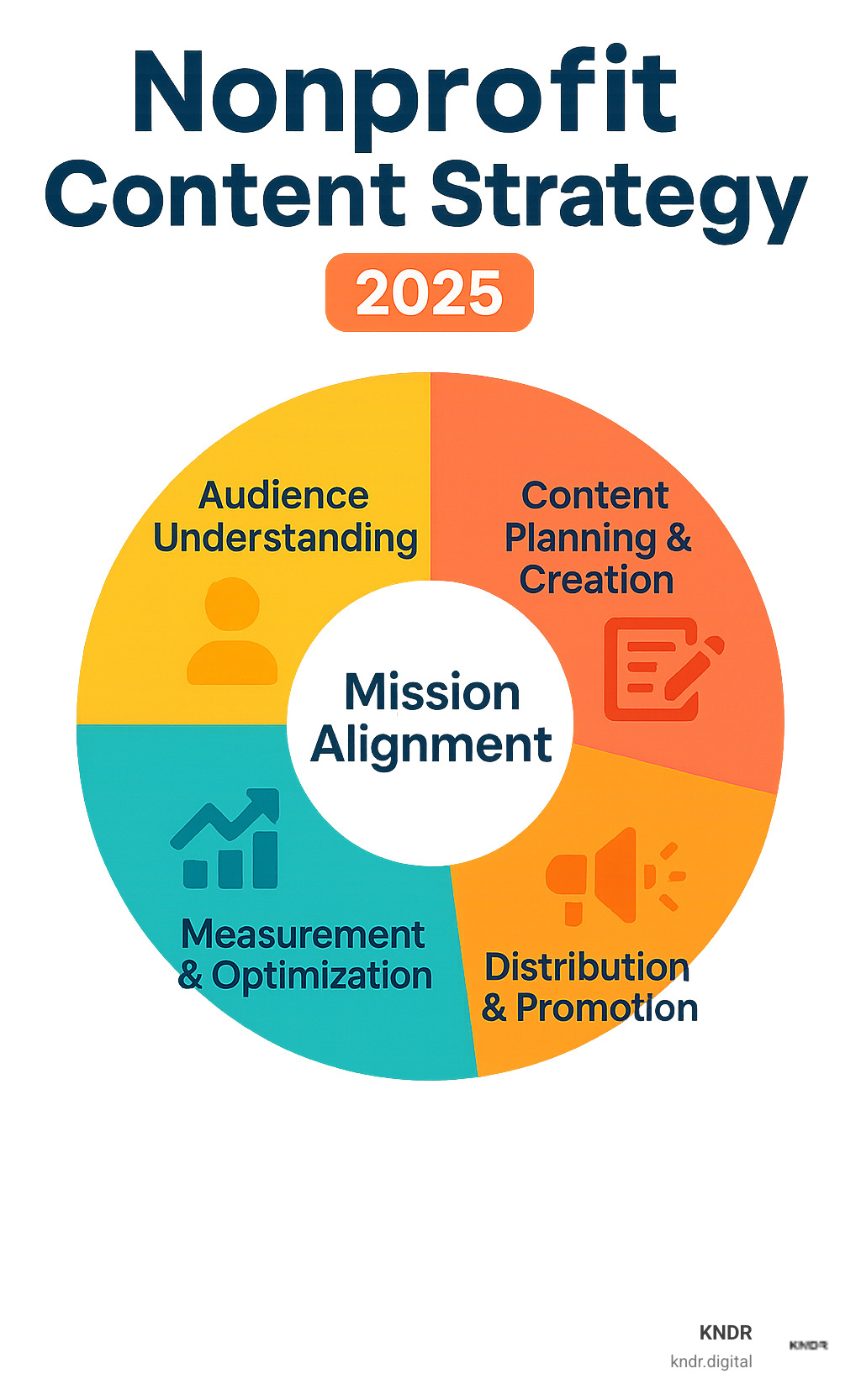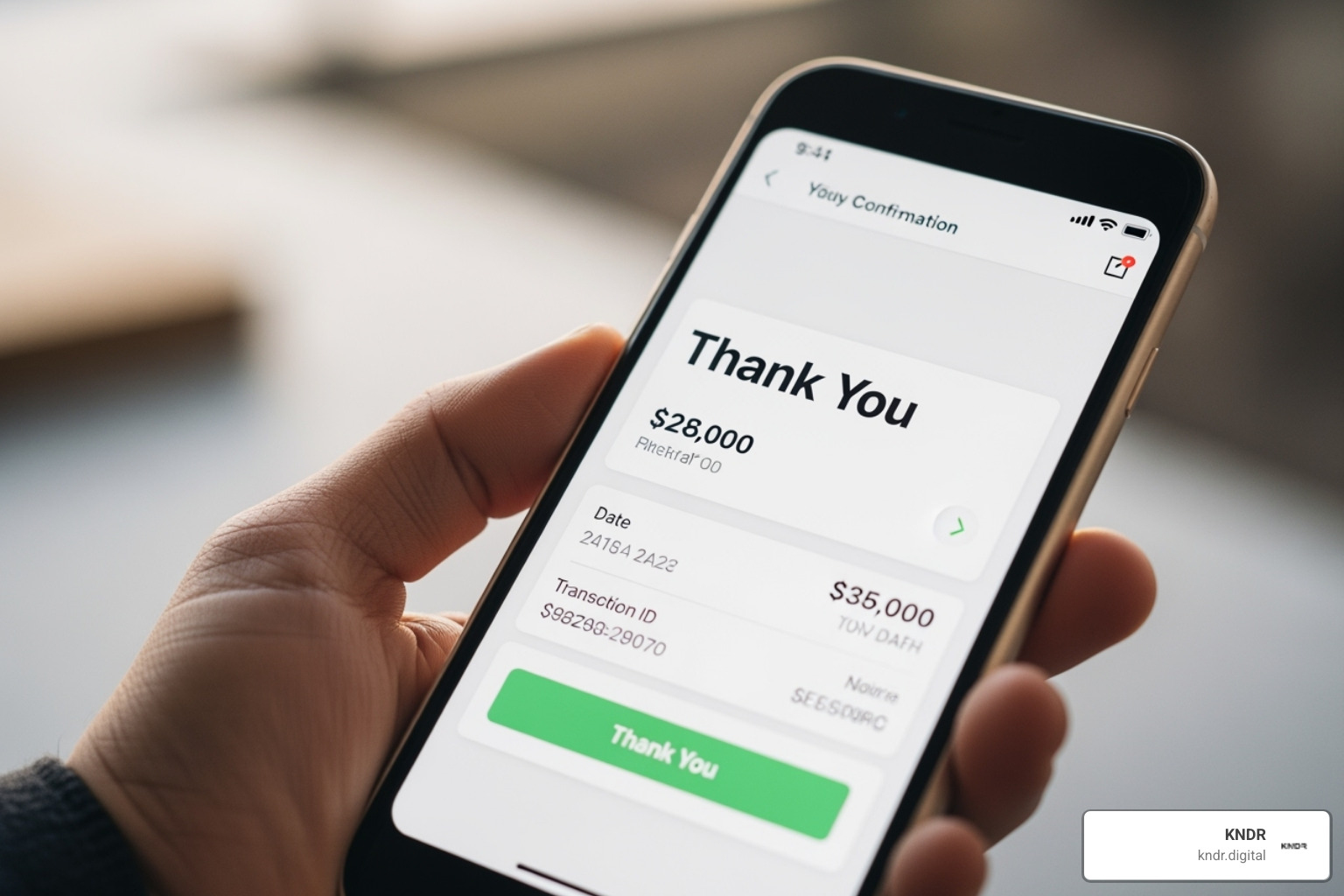Nonprofit Content Strategy: Because 'Going Viral' Isn't a Plan

Why a Nonprofit Content Strategy is Essential
A nonprofit content strategy is your roadmap for clear, impactful communication. It's a plan that helps your organization attract supporters, inspire giving, and achieve its mission.
Here’s what a robust nonprofit content strategy includes:
- Clear Goals: What do you want to achieve with your content?
- Audience Understanding: Who are you trying to reach and why?
- Content Planning: What stories will you tell and in what formats?
- Distribution Channels: Where will your content live and be shared?
- Measurement: How will you track success and improve?
Nonprofits often face tough challenges. Resources are tight, and teams are small. In fact, most nonprofit content teams have fewer than five people. Despite this, 92% of nonprofits use content marketing in some way. But here's the catch: only about a quarter of them have a documented content strategy or feel their efforts are truly effective. This means a lot of wasted time and energy.
Without a clear plan, content can fall flat. It might not reach the right people, or it might not inspire them to act. This guide will give you a step-by-step framework to build a strong, mission-driven content strategy. It's about working smarter, not just harder.
As a founder and digital change leader, Mahir Iskender helps mission-driven organizations scale with smart technology. He leads KNDR.digital, specializing in AI-powered marketing and digital fundraising, with deep expertise in nonprofit content strategy. This foundation is critical for everything that follows.

Nonprofit content strategy vocabulary:
What is a Nonprofit Content Strategy (And Why It's Your Most Valuable Asset)
Let's kick things off by really understanding what a nonprofit content strategy is all about. It's not just a fancy term; it's your secret weapon for making a real difference!
Simply put, a nonprofit content strategy is your clear plan for creating and sharing valuable, consistent content. Its main job? To attract and keep the amazing people who care about your cause. Think of it as telling your story in a way that truly connects with your audience, sparking their interest and inspiring them to join your mission. This goes way beyond just sharing a few social media posts or wishing a video goes viral. It’s a thoughtful, purposeful plan built to help you hit your biggest goals as an organization.
You know, creating content is a lot like an iceberg. What you actually see published – the blog posts, the videos, the social updates – that's just the tip! Underneath the surface is a huge amount of hard work: deep research, careful planning, really understanding who you're talking to, and then measuring how well everything is working. This solid foundation helps you build trust, teach your audience new things, and ultimately drive the actions that push your mission forward. We're not just creating content to fill a space; we're using it as a super powerful tool to bring in supporters, raise funds, and spread awareness for your incredible work. Want to dive deeper into how digital marketing fits into this? Check out More info about Digital Marketing for Charities.
Why a Documented Strategy is Crucial
You might be thinking, "Why should I bother writing all of this down?" And that's a fair question! But here’s a little secret: a lot of nonprofits are, well, a bit lost when it comes to content. Believe it or not, only about one in four nonprofits actually has their content strategy written down or feels like their efforts are truly working. That's like trying to steer without a map – you might get somewhere, but it's probably not where you intended!
Having a documented nonprofit content strategy is like having that super clear roadmap. It makes sure everyone on your small, dedicated team (and let's be honest, most nonprofit content teams are pretty lean, often with fewer than five people!) is heading in the exact same direction. This means no wasted time doing the same thing twice, saving those precious resources, and keeping your message consistent across the board. Plus, it helps you show exactly why your marketing spending is so important, connecting your content efforts directly to results that matter – focusing on real impact instead of just how many "likes" you get. With a solid plan in hand, you can even empower your amazing volunteers to jump in and help, knowing their contributions truly support your big goals. For a fantastic example of how a clear strategy leads to incredible success, take a look at the work of charity: water. They inspire action through powerful stories and a commitment to transparency!
From Mission Statement to Content Mission
Every single nonprofit starts with a powerful reason for being – your mission. And guess what? Your nonprofit content strategy isn't just related to that mission; it is an extension of it! It's all about taking your big organizational mission and turning it into a clear, exciting content mission.
So, ask yourself: "How does every piece of content we create directly support our overall goals?" For example, if your organization's big mission is to bring clean water to communities, your content mission might be to "educate and inspire people around the world to support lasting water solutions." See how they connect?
Here's another important point: a great content strategy also clearly defines what you won't do. With limited time and resources, you simply can't do everything or be everywhere. By setting clear boundaries, you keep your team focused and avoid getting pulled in too many directions by every new trend. This focused approach also ensures that all your marketing efforts work hand-in-hand with your fundraising goals. Every blog post, every impact story, every call for volunteers – it all works together to boost your overall success. Curious to learn more about how this strategic planning fits into bigger picture fundraising? Dive into developing a Charity Campaign Strategy.
The 4 Pillars of a High-Impact Nonprofit Content Strategy
Building a truly effective nonprofit content strategy is a lot like constructing a sturdy building. You need strong foundational pillars to support everything you create, from the smallest social media post to your biggest fundraising campaign. These pillars ensure your efforts have purpose, stability, and lasting impact.
Pillar 1: Define Your Goals and Audience
Before you even think about what to write or where to post it, you need to know two crucial things: why you're creating content and who you're trying to reach. This might sound obvious, but it's the absolute bedrock of your nonprofit content strategy.
First, let's talk about your goals. Forget vague wishes like "we want more donations." Instead, aim for SMART goals: ones that are Specific, Measurable, Achievable, Relevant, and Time-bound. For instance, a SMART goal could be: "Increase monthly online donations by 15% within the next six months by showcasing inspiring donor impact stories." See the difference? These goals must always tie back directly to your mission and overall organizational objectives.
Next, you need to really get to know your audience. Nonprofits often communicate with many different groups. Think about your constituents, your amazing volunteers, individual donors, big corporate sponsors, and even policymakers. Each of these groups has unique needs, motivations, and preferred ways to get information.
That's why creating detailed audience personas for each group is so powerful. For example, a potential donor might be moved by emotional stories, while a corporate funder might want to see data on efficiency and return on investment. Did you know that volunteers are actually twice as likely to donate as non-volunteers? Understanding these nuances helps you tailor your content to truly resonate. Tools like A guide to AI-Powered Donor Segmentation can be a game-changer here, helping you understand what makes each group tick.
Pillar 2: Choose Your Content and Channels
Once you know your goals and who you're talking to, the fun begins: deciding what to say and where to say it! The most effective content for nonprofits isn't just pretty; it informs, inspires, and drives action, always aligning with your mission.
Here are some content types that consistently deliver for nonprofits:
- Blogs and News Articles are fantastic for sharing updates, educational insights, and deeper dives into your cause. They're also great for helping people find you through search engines.
- Impact Stories and Case Studies are arguably your most powerful tool. They put a human face on your work, showing the real, tangible results of support. Think about the story of Georgina, a widowed dairy farmer whose life was changed by a bicycle from World Bicycle Relief. Stories like hers have an incredible ability to motivate donors.
- Videos are super engaging! Visual content is processed 60,000 times faster than text, and 60% of people consume video thoroughly. They're perfect for sharing testimonials, explaining complex issues simply, or giving a quick tour of your work.
- Infographics are your best friend for making data easy to understand and shareable.
- Newsletters are essential for staying in direct touch with your supporters, volunteers, and donors, keeping them informed and engaged. Email is a significant driver of revenue for many nonprofits.
- Webinars and Online Training are excellent for educating your audience on topics related to your mission or for training new volunteers.
- Annual Reports, traditionally a bit dry, can be transformed into engaging, multimedia experiences that beautifully showcase your year's impact.
After creating compelling content, you need to get it out there! Your main distribution channels will typically include:
- Your Website: This is your digital home base, where all your important content, impact stories, and calls to action live.
- Email Marketing: A direct line to your supporters, perfect for nurturing relationships and driving donations.
- Social Media: Platforms like Facebook, LinkedIn, Instagram, and Threads are crucial for sharing snippets, engaging with your community, and bringing people back to your website.
- Search Engine Optimization (SEO): Making sure your content is easily found when people search for topics related to your cause.
For more tips on crafting those powerful narratives, be sure to check out our Nonprofit Storytelling Framework.
Pillar 3: Create and Execute with Limited Resources
"How on earth do we do all this with such a small team?" We hear this question all the time, and it's a completely valid one! The secret isn't more hours; it's smart planning and making every single resource count.
Your content calendar will become your new best friend. Planning at least a quarter in advance helps you spread out deadlines, keep a steady flow of fresh content, and avoid that last-minute panic. It also makes it easy to align your content with fundraising campaigns, awareness days, and seasonal events.
Repurposing content is another superpower for small teams. Imagine: one well-researched blog post can be broken down into multiple social media updates, an eye-catching infographic, a snippet for your email newsletter, or even the script for a short video. This ensures that every piece of content works harder for your cause.
You can also tap into the incredible power of your community through user-generated content (UGC). Encourage your volunteers, the people you serve, and your donors to share their own stories, photos, and testimonials. Not only does this lighten your content creation load, but it also adds incredible authenticity and social proof.
Finally, this is where automation and smart technology truly shine. With KNDR's AI-driven systems, you can streamline so many content-related tasks. Think about personalizing donor communications or figuring out the best times to post. This frees up your lean team to focus on strategy and high-impact creative work, instead of getting bogged down in repetitive tasks. If you're curious about leveraging tech, explore the Best AI Tools for Nonprofits.
Pillar 4: Measure, Analyze, and Improve
Your nonprofit content strategy isn't a "set it and forget it" kind of deal. To make sure you're continuously improving and proving your impact, you need to constantly measure, analyze, and adapt.
Start by setting Key Performance Indicators (KPIs) that are directly linked to your SMART goals. These are simply the ways you'll know if your content is doing its job. Your KPIs might include:
- Website Traffic: How many unique visitors you get, page views, how long people stay on your site, and if they bounce away quickly.
- Social Media Engagement: Likes, shares, comments, how many people see your posts, and how much traffic you drive back to your website.
- Email Marketing Metrics: Your open rates, click-through rates, and if too many people are unsubscribing.
- Donation Conversion Rates: How many people who saw your content went on to make a donation.
- Volunteer Sign-ups: Tracking how your content inspires people to give their valuable time.
You'll use tools like Google Analytics to track website performance and check the native analytics on your social media platforms. Integrating data from your CRM (Customer Relationship Management) system is also key, as it helps you connect content engagement directly to donor behavior and their lifetime value. This data is gold! It tells you what's working, what's not, and where you need to pivot your efforts. Measuring and reporting on your content helps you show how it supports your strategic goals and even feeds back into creating better content in the future. To dive deeper into analytics, check out Top Nonprofit Analytics Platforms.
Supercharging Your Strategy: Tips for Small Teams

Tiny teams can still make a huge impact. Below are battle-tested tactics our clients use to squeeze the absolute most value out of every hour and every dollar.
1. Leverage Free Tools and Grants
- Google Ad Grants \u0010\u0014 Secure up to $10,000/month in free search ads to amplify high-intent keywords that drive donations and volunteer sign-ups.
- Canva for Nonprofits provides premium design features at no cost\u0014perfect for social graphics, reports and presentations.
- Free scheduling platforms like Buffer or Later let you batch content in advance, keeping your feeds active even when you\u0019re juggling events.
- Stock-photo libraries such as Unsplash and Pexels supply high-quality visuals without licensing headaches.
2. Master the Art of Repurposing
1 long-form blog can become:
- 5–7 social posts highlighting key facts or quotes
- 1 infographic summarising statistics
- A short video or Reel using the same narrative arc
- An email newsletter intro with a "read more" CTA
This multiplies reach while slashing production time.
3. Build a Content-Contributing Community
- Invite volunteers or beneficiaries to share first-person stories\u0014UGC is authentic and highly engaging.
- Launch a brand-ambassador programme where supporters receive social badges or early updates in exchange for spreading the word.
- Guest posts from partner organisations help you fill the calendar and cross-pollinate audiences.
For deeper relationship-building tactics, see our guide on Donor Relationship Management.
4. Automate Wherever Possible
AI-driven email sequences, smart social scheduling and CRM integrations cut manual work dramatically. Explore our roundup of the Best AI Tools for Nonprofits to identify quick wins your team can implement this quarter.
Remember: consistency beats complexity. Start small, systemise what works, and watch your impact compound month after month.
Frequently Asked Questions about Nonprofit Content Strategy
It's natural to have questions when you're building something new, especially a robust nonprofit content strategy. We often hear similar questions from dedicated teams like yours. Let's tackle some of the most common ones that can help you move from planning to powerful impact.
How often should a nonprofit post content?
This is one of the most common questions we hear, and it really comes down to a simple truth: quality over quantity. There's no magic number of posts per day or week that guarantees success. Instead, focus on consistency that truly aligns with what your team can realistically manage.
Think about it this way: it’s much better to share one high-quality, thoughtful, and engaging piece of content each week than to rush out five pieces that feel incomplete or uninspired. Your audience will appreciate the effort and depth. A realistic content calendar is your best friend here. If that means one detailed blog post a month and a few engaging social media updates each week, that’s perfectly fine! The goal is to build an expectation with your supporters and consistently meet it, week after week. This steady rhythm helps you plan, reuse content wisely, and make the most of your valuable, limited resources.
How can I get buy-in from my board for content marketing?
Getting your board on board is absolutely vital, especially since they often guide the organization's strategic direction and financial decisions. The secret to gaining their support lies in speaking their language: Return on Investment (ROI). Show them how content marketing isn't just a "nice-to-have" but a powerful tool that directly supports their main concerns: bringing in more donations, attracting new supporters, and fulfilling your mission.
Present a clear, well-thought-out nonprofit content strategy document. This should outline your SMART goals (Specific, Measurable, Achievable, Relevant, Time-bound), describe who you're trying to reach, explain the types of content you'll create, and detail how you'll share it. Most importantly, include your plan for how you’ll measure success. Use data to show what’s already working – whether it’s increased website traffic, new email sign-ups, or even how content helps convert casual readers into loyal donors. Highlight how content powerfully supports Data-Driven Fundraising by building stronger relationships with donors and creating a steady stream of support. When your board sees content as a measurable investment that brings tangible results, getting their buy-in becomes much, much easier.
What is the single most important type of content for a nonprofit?
While a diverse mix of content is always beneficial for a well-rounded nonprofit content strategy, if we had to pick just one type, it would hands down be impact stories.
Nonprofits thrive on creating deep connections and inspiring empathy. Impact stories are incredible because they show exactly where donations go and highlight the real, positive change you're making in the world. They put a human face on your mission, sharing authentic, human-centered narratives that build a powerful emotional connection with your audience.
These stories aren't just feel-good anecdotes; they clearly demonstrate the tangible results of support. Whether it’s a child finally getting access to education, a family receiving clean drinking water, or an animal finding a loving home, these narratives move people. They shift your audience from simply being aware of your cause to actively wanting to help. When you tell these stories effectively, you inspire action not through guilt, but through the powerful emotion of hope and positive change. This is how you can truly boost donations with compelling content and build lasting, meaningful relationships with your incredible supporters.
From Plan to Impact: Activating Your Strategy

Phew! We've covered a lot of ground together, haven't we? From understanding what a nonprofit content strategy truly means to building it piece by piece with our four pillars, and even finding clever ways to boost it with a small team.
The big takeaway? Having a clear, documented strategy isn't just a nice-to-have. It's your blueprint for success. It helps your whole team pull in the same direction, makes sure your efforts are focused where they matter most, and directly links your daily work back to your amazing mission.
The goal isn't to chase fleeting trends or "go viral" just for a moment. Instead, it's about building a strong, lasting community of supporters. People who truly connect with your cause and are ready to stand with you, offering their time, resources, and donations consistently. That's the kind of deep, long-term impact that truly changes lives.
For those of you ready to take your strategy to the next level, especially with the power of modern technology, we're here to help. At KNDR, we specialize in advanced, AI-driven systems designed to streamline your efforts and deliver real results. We can help turn your well-thought-out nonprofit content strategy into a powerful engine for fundraising and mission fulfillment.
Ready to see your content strategy drive tangible change and boost your impact? Let's explore how our digital fundraising services can empower your mission. Click here to learn more.



